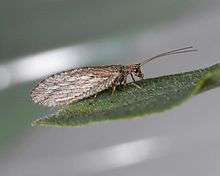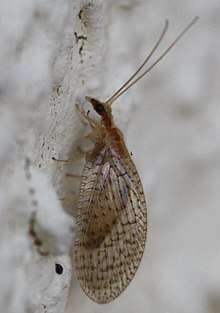Hemerobius
Hemerobius is a genus of lacewings in the family Hemerobiidae. It is found throughout Europe and North America.[1] Like most lacewings, both the larvae and adults are predatory, primarily eating acarines, scale insects, psyllids, aphids, thrips, and the eggs of lepidopterans and whiteflies.
- Names brought to synonymy
- Hemerobius elegans Stephens, 1836 (currently Sympherobius elegans)
- Hemerobius elegans Guérin-Méneville, 1844 (currently Vieira elegans)[2]
| Hemerobius | |
|---|---|
 | |
| Hemerobius stigma | |
| Scientific classification | |
| Kingdom: | Animalia |
| Phylum: | Arthropoda |
| Class: | Insecta |
| Order: | Neuroptera |
| Family: | Hemerobiidae |
| Subfamily: | Hemerobiinae |
| Genus: | Hemerobius Linnaeus, 1758 |
| Species | |

Hemerobius humulinus
See also
References
- The Global Biodiversity Information Facility: GBIF Backbone Taxonomy, 2013-07-01. Accessed via https://www.gbif.org/species/1730162 on 2013-11-02
- Hemerobius elegans Stephens, 1836 (currently Sympherobius elegans) and Hemerobius elegans Guérin-Méneville, 1844 (currently Vieira elegans) (Insecta, Neuroptera): proposed conservation of the specific names. JD Oswald, Bulletin of Zoological Nomenclature, Volume 64, Issue 3, pages 174-177
External links


- "Hemerobius" at the Encyclopedia of Life

- "Hemerobius". National Center for Biotechnology Information (NCBI).
- Hemerobius at Fauna Europaea
- "Hemerobius". Integrated Taxonomic Information System.
This article is issued from Wikipedia. The text is licensed under Creative Commons - Attribution - Sharealike. Additional terms may apply for the media files.